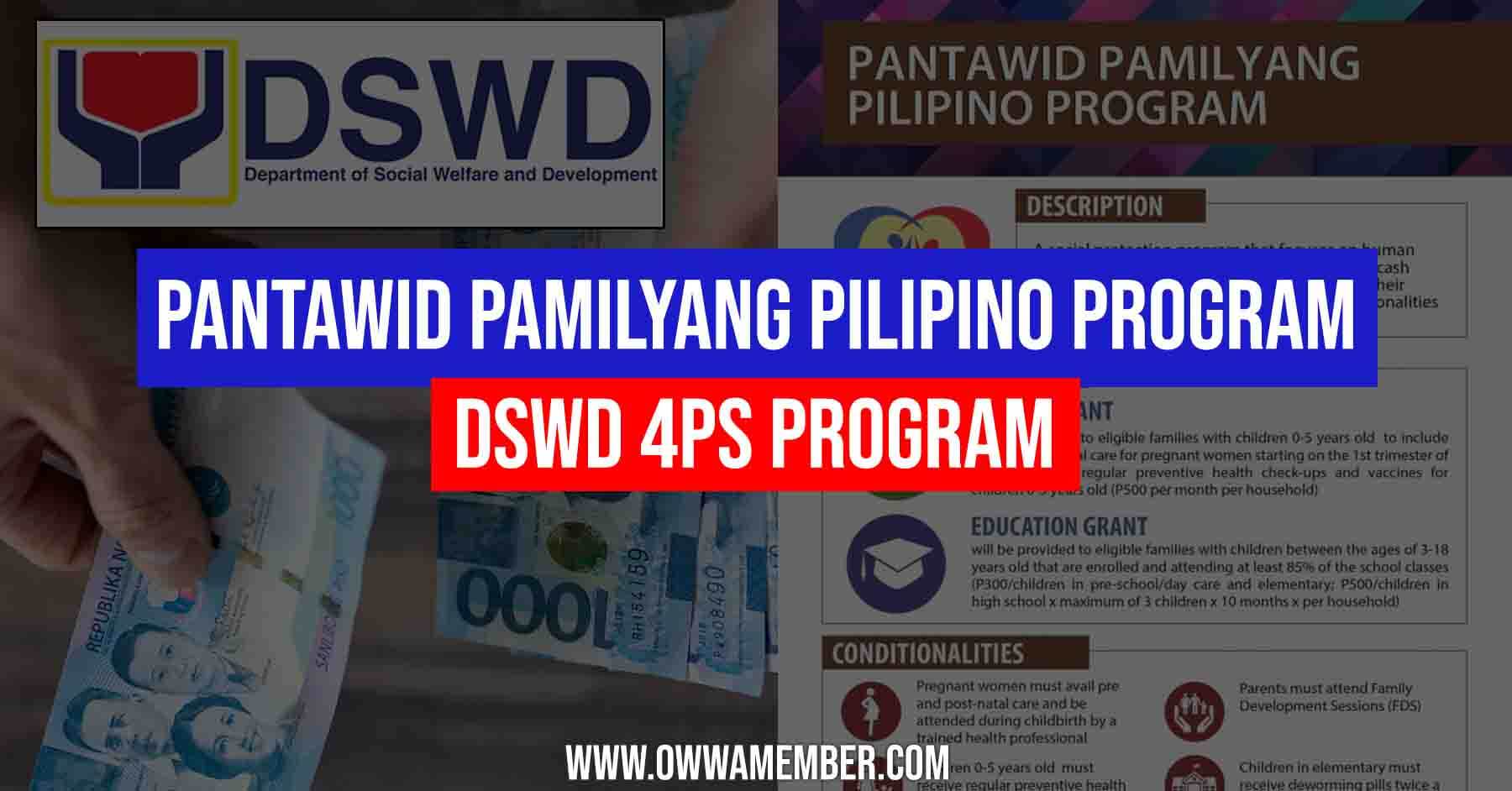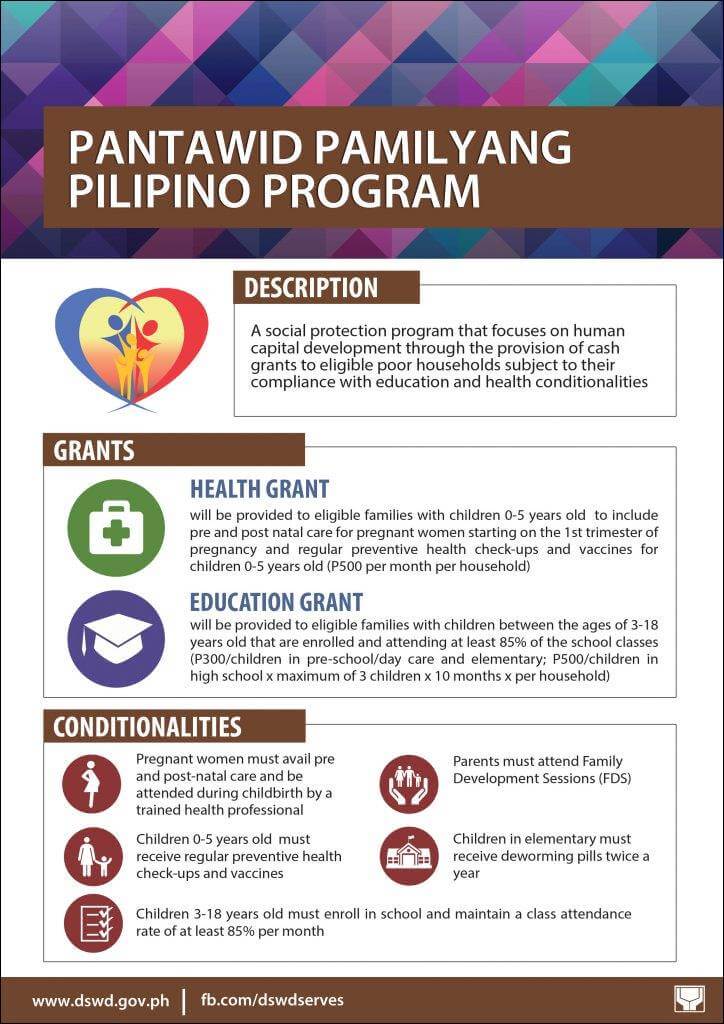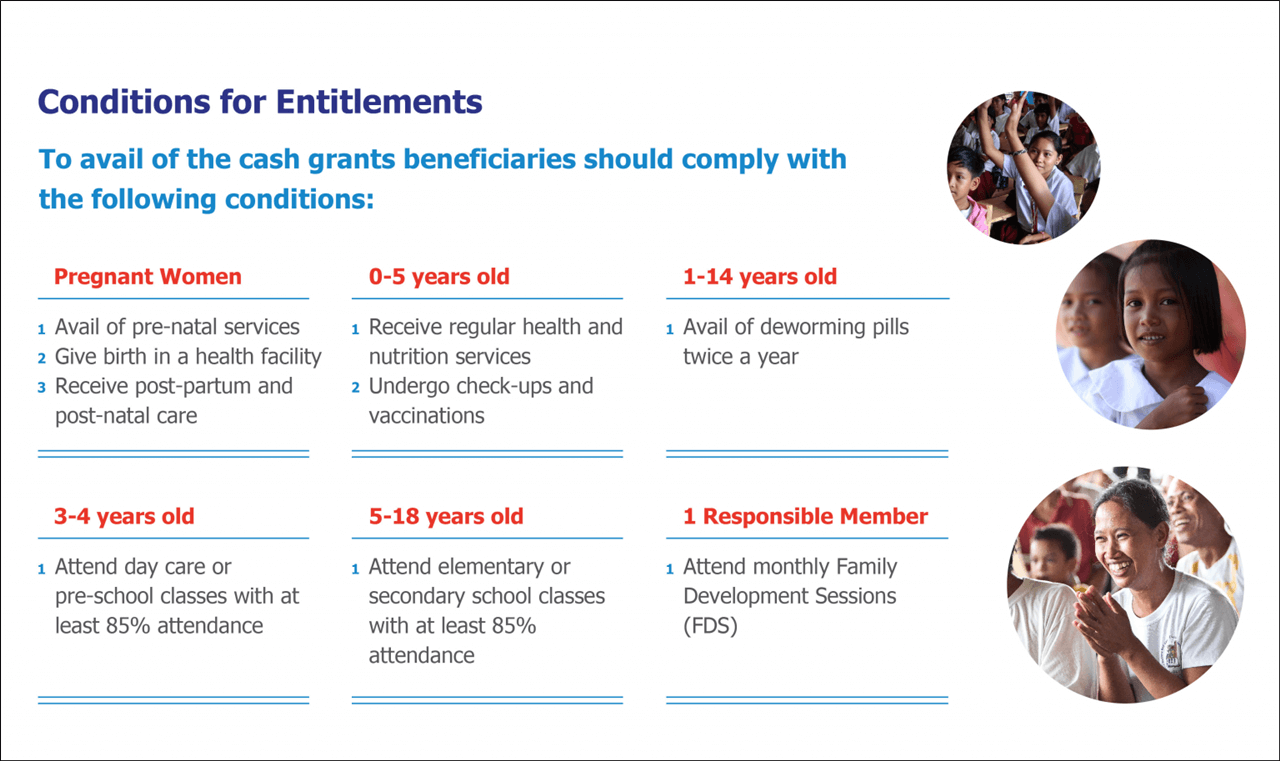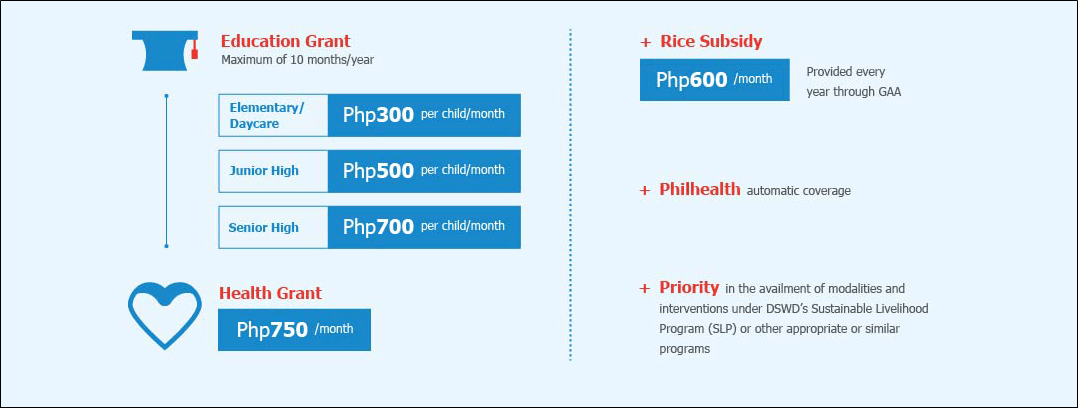The DSWD Pantawid Pamilyang Pilipino Program (4Ps) is a conditional cash transfer program of the Philippine government under the Department of Social Welfare and Development. The program aims to eradicate extreme poverty in the Philippines by investing in health and education, particularly for ages 0–18.
The 4Ps program is one of the Philippine government’s most successful anti-poverty programs and has helped lift 1.6 million people out of poverty. In this guide, we share the application process for the DSWD Pantawid Pamilyang Pilipino Program (4Ps).
We cover steps to apply, requirements and documents required, as well as important reminders. Read on to learn more.
Contents
- What is DSWD Pantawid Pamilyang Pilipino Program (4Ps)?
- Benefits of Pantawid Pamilyang Pilipino Program (4Ps)
- Qualifications for the Pantawid Pamilyang Pilipino Program (4Ps)
- Requirements for the Pantawid Pamilyang Pilipino Program (4Ps)
- How to Process DSWD Pantawid Pamilyang Pilipino Program (4Ps)
- PDF Copy of DSWD Pantawid Pamilyang Pilipino Program (4Ps) Operation Manual
- Video: Paano pinipili ng DSWD kung sino ang aalisin sa 4Ps beneficiaries?
- Frequently Asked Questions
- 1. How many children can you have in 4Ps?
- 2. What is the selection of the poorest municipalities from the above provinces based on?
- 3. What are the 4Ps?
- 4. How many steps are there in identifying beneficiaries?
- 5. What is social assistance?
- 6. Is 4Ps a development program?
- 7. Is the 4Ps a charity?
- 8. Does the 4Ps help with dependency?
- Summary

What is DSWD Pantawid Pamilyang Pilipino Program (4Ps)?
The Pantawid Pamilyang Pilipino Program (4Ps) is the national poverty reduction strategy of the government, as stated under Republic Act No. 11310 or “An Act institutionalizing Pantawid Pamilyang Pilipino Program (4Ps)” which was signed on April 17, 2019.
Patterned after the conditional cash transfer scheme implemented in other developing countries, 4Ps provides cash grants to beneficiaries provided that they comply with the set of conditions required by the program.
Purpose of the 4Ps Program
The Pantawid Pamilyang Pilipino Program (4Ps) is a government program that provides monetary assistance to the poorest of the poor Filipino families in order to help them in their basic needs.
The government also provides social assistance to these families in order to help them with health-related concerns such as deworming of children (6-14 yrs. old), and check-up for children starting from birth up to five years of age & pregnant women.
The government ensures that the children will enroll in daycare, elementary, and secondary schools. It also conducts development sessions for families and deworming of children from 6-14 yrs. old.
4Ps Coverage
The 4Ps are programs that target the poor in different areas across 1,484 municipalities, 143 cities, and 79 provinces in the country. The National Household Targeting System for Poverty Reduction is responsible for identifying the poor and where they live.
As of August 26, 2015, there were over 4 million active beneficiaries of the 4Ps. These include over 10 million school children. Through the cash grants, the program is able to provide financial assistance to these families.
Before August 2015, the program had given out over Php27.15 billion in cash grants to its beneficiaries. Out of these, over Php13 billion was allocated for education and health grants.

Benefits of Pantawid Pamilyang Pilipino Program (4Ps)
- The program provides financial assistance to households in need, helping to cover essential expenses such as healthcare and education.
- Education Grant (Maximum of 10 months/year)
- Elementary / Daycare – Php 300 per child/month
- Junior High – Php 500 per child/month
- Senior High – Php 700 per child/month
- Health Grant – Php 750/month
- +Rice Subsidy – Php 600/month (provided every year throuogh GAA)
- +Philhealth automatic coverage
- +Priority in the availment of modalities and interventions under DSWD’s Sustainable Livelihood Program (SLP) or other appropriate or similar programs
- The program aims to improve the health and education outcomes of children from disadvantaged backgrounds.
- The program has effectively reduced poverty and improved beneficiaries’ wellbeing.

Qualifications for the Pantawid Pamilyang Pilipino Program (4Ps)
The 4Ps is available to families with children living in the poorest 40 percent of households in their local areas. This is according to the results of a 2003 survey conducted by the National Statistical Coordination Board (NSCB).
The poorest families are selected through a proxy-based method. Economic indicators such as the ownership of assets, income, education, and access to sanitation and water facilities are used to determine the family’s economic category.
Aside from farmers and fisher folk, other vulnerable individuals such as indigenous peoples, homeless families, and informal settlers are also included in the DSWD’s standard targeting system. However, these individuals still have to meet the requirements to be eligible for cash grants.
In order to be eligible for Pantawid Pamilyang Pilipino (4Ps), you must:
– Be a resident in one of the poorest municipalities (based on the 2003 SAE)
– Be part of a household whose economic status is below the provincial poverty level
– Have children between 0 and 18 years old or have a pregnant member of your family when the assessment was made
As you can see, there are strict qualifiers for being part of the 4Ps program. Suppose you meet all of these requirements and are still having trouble enrolling your family in the Pantawid Pamilyang Pilipino Program. In that case, it is possible that this particular initiative does not yet cover your municipality. You will have to wait until they can include your community in their list of beneficiaries.
Meantime, you can still apply for other government aid programs available to you, some of which do not apply to 4Ps beneficiaries, such as the DSWD’s AICS Program.

Requirements for the Pantawid Pamilyang Pilipino Program (4Ps)
Due to the program’s requirements, many families cannot register. Families must submit the necessary documents in the respective barangays to be eligible.
- Copies of birth certificates for all family members.
- Copies of school IDs or first grading period school report cards of all children in the family who attended school.
- Barangay certificate.
- 2 1″x1″ picture with white background (taken between March-September 2012) for the Program ID and Land Bank ATM ID.
- Copy of health records of 0-5 years old from the health center where they have their check-ups.
- Valid IDs of the family member attending the community assembly.
In April and May 2015, the program’s compliance rate was high. In the 6-14 age group, 98.9% of children were dewormed, while in daycare, 97.1%, and in school, 98.99%. In the family development sessions, 94.8% of participants were compliant, while 95.6% of pregnant women were checked.
Conditions and Compliance
The conditions and compliance for the Pantawid Pamilyang Pilipino Program (4Ps) are as follows:
-Parents/guardians must be present during family development sessions where topics on health, nutrition, and responsible parenting will be discussed.
-Children from 6-14 years old must be given deworming pills 2x per year.
-Pregnant women must be given pre and postnatal care. She must be attended by a skilled professional while giving birth.
-Children aged 3 to 18 who are beneficiaries must be able to enroll in school and should complete attendance of 85% at the least per month.
-There should be a regular check-up for children; 0-5 years of age
How to Process DSWD Pantawid Pamilyang Pilipino Program (4Ps)
Beneficiary Selection
The list of poor households (HHs) that the NHTS-PR considers as potential beneficiaries is forwarded to the PMED of the 4Ps NPMO for evaluation and planning. The PMED then conducts an eligibility check routine to identify these individuals.
The list of eligible HHs is then forwarded to the BDMD for registration and validation.
Beneficiary Registration
The process of enrolling eligible beneficiaries in the program is known as beneficiary registration. It involves providing various documents to complete the necessary steps to collect the correct data.
This process should be conducted thoroughly to ensure that the data is accurate and that the procedures are carried out properly. In addition to being able to provide the necessary information to the program, beneficiary registration also affects various other activities, such as payment and compliance verification.
Payments
The DSWD and the BRFI are currently working on the appropriate mode of payment for cash grants. The two entities will then agree on the best MOP for the cash grants.
- Transaction account is a type of payment that allows one to receive and transfer both e-money and cash. It is mainly used to promote the savings of HH-beneficiaries and to encourage them to use agent banking. An agent banking is a type of branchless banking that involves a bank entering into an agreement with a retail outlet to provide financial services.
- A cash card or prepaid card is a type of payment that allows the beneficiaries to withdraw their cash grants from an ATM or a POS terminal operated by the BRFI or the AGDB.
- In the event that there are no POS terminals or ATMs in the area, the BRFI, AGDB, or DSWD can use authorized over-the-counter conduits to distribute cash grants. These include banks, money couriers, cooperatives, and postal companies. These entities are in compliance with existing regulations and laws.
PDF Copy of DSWD Pantawid Pamilyang Pilipino Program (4Ps) Operation Manual
Please check out PDF copy manual of the 4Ps program by DSWD here – https://pantawid.dswd.gov.ph/wp-content/uploads/2022/08/08152022_4ps_OM_print.pdf
The 4Ps Operation Manual details the operating procedures for the BRFI and AGDB, as well as other government agencies involved in the distribution of cash grants to qualified households.
It also details the rules on how DSWD will process applications for Pantawid Pamilya beneficiaries.
Video: Paano pinipili ng DSWD kung sino ang aalisin sa 4Ps beneficiaries?
Around 1.3 million Filipinos of 4Ps are no longer considered poor, according to the DSWD. But what does DSWD consider “poor”? How can you say you can be part of the program? Watch the interview with DSWD Asec. Romel Lopez.
https://youtu.be/GlUWVMYnnxM
Frequently Asked Questions
Please check out these FAQs about the DSWD 4Ps Program:
1. How many children can you have in 4Ps?
For a child to attend school, you can expect to receive around P3,000 for one year or around 300 per month for 10 months. A maximum of three children in a household can be allowed.
2. What is the selection of the poorest municipalities from the above provinces based on?
The list of the poorest municipalities in each province is based on the results of the FIES and Small Area Estimates surveys.
3. What are the 4Ps?
The 4Ps is focused on providing cash assistance to the poor and developing a sustainable social development framework. These include: 1) addressing the short-term needs of the poor and 2) investing in human capital.
4. How many steps are there in identifying beneficiaries?
There are three steps in identifying the beneficiaries:
- Provinces were selected using the following criteria: a) 20 poorest provinces based on the 2006 Family Income and Expenditure Survey (FIES); b) Poorest provinces in six regions without a province in the list of the 20 poorest provinces; c) Five cities in the NCR, two in the Visayas, two in Mindanao and one in the Cordillera.
- The selection of the poorest municipalities from the above provinces based on the Small Area Estimates (SAE) and FIES where saturation surveys of households are being conducted.
- Computerized selection of the poorest households based on a ranking system using Proxy Means Test developed for the program.
Social Assistance – to provide cash assistance to the poor, to alleviate their needs (short term poverty alleviation)
6. Is 4Ps a development program?
The goal of 4Ps is to invest in human capital. It provides cash assistance to needy families, but they must meet certain conditions in order to receive it. It encourages parents to help their children fulfill their responsibilities and improve their lives.
7. Is the 4Ps a charity?
The 4Ps is not merely for the poor children in the country, but for the long-term growth of the nation. It is very important that we equip our workers and future citizens with the necessary skills and knowledge to compete in the global economy. Unfortunately, the 4Ps does not create jobs.
8. Does the 4Ps help with dependency?
According to the evaluation of the 4Ps, the program’s design has successfully mitigated the effects of dependency on poor families. For instance, by increasing child investments, poor families are more likely to support themselves. These are positive reasons to continue investing in the program.
Summary
The DSWD has a strong case for the 4Ps. The program is not perfect, but it has helped a lot of Filipino families. It is important that we continue investing in it because there are still many families who need help.
Also Read: How to Avail DSWD Sustainable Livelihood Program
We hope that through this guide and other relevant resources, more qualified families can access the program and continue to benefit from it. But with it, our hope is also for more poor families to “graduate” from the program as this means that they are now self-sufficient and no longer need government assistance. With the help of the DSWD, we hope that more families will be able to leave poverty behind.